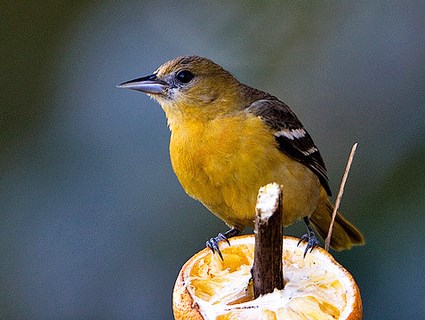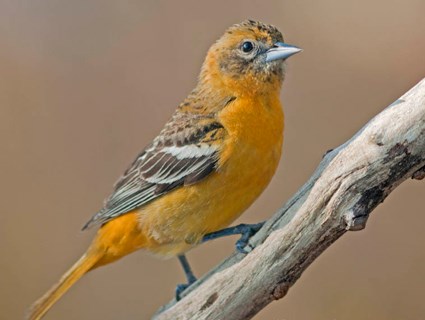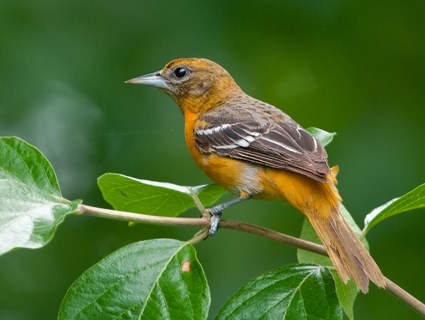A pair of Baltimore orioles appeared to feed on Cutie tangerine halves a few days ago. It seems our next door neighbor must be providing a more abundant supply of preferred food as they seem to be sporadic visitors at our feeders. Interestingly I first observed them eating seed at our green-roofed birdhouse on the deck and have observed them returning to look for more seed. Maybe adding grape jelly to our offerings will entice them to spend more time visiting our feeders.

Baltimore Oriole
Adult male
- Slender body shape with sharp, pointed bill
- Bright orange underparts with black head
- Black and white wings with orange shoulders
- Black tail tipped with orange
- Common spring/summer resident in eastern and central U.S.
- © Joseph Knoll/PFW, GA, St Marys, December 2006

Baltimore Oriole
Adult male
- Bright orange with black head
- Bold white markings on black wings
- Sharp silver/black bill
- © The Nature Nook, MA, May 2009

Baltimore Oriole
Immature male
- Slender body shape and long tail
- Sharp, pointed bill
- Bright orange underneath
- Dusky gray head and back
- © Ruthie Kansas, KS, Topeka, May 2009

Baltimore Oriole
Adult male
- Jet black head and upper back
- Black and white wings
- Bright orange rump
- Black tail with orange tips
- © B. Van Halen, May 2010

Baltimore Oriole
Immature female
- Long, pointed gray bill
- Yellow-orange breast
- Dark gray wings with white bars
- Olive-gray head and back
- © Robert Strickland, FL, Beverly Hills, February 2010

Baltimore Oriole
Adult male at nest
- Brilliant orange and black
- Distinctive, woven basket-shaped nest hangs from branch
- © Gary Tyson, PA, Hammond Lake, Tioga, June 2006

Baltimore Oriole
Adult female
- Orange breast and tail
- Long, orange tail
- White bars on gray wings
- Head mottled gray and orange
- © John Rowe, NH, Ossipee, May 2011

Baltimore Oriole
Adult female
- Pointed silvery gray bill
- Head mottled gray, olive and orange
- Bright orange underneath
- © Joel DeYoung, MI, Holland, May 2011

Baltimore Oriole
Adult male
- Elongated body shape with long tail
- Bright orange underneath with black head
- Black and white wings
- Orange and black tail
- © Matt Bango, NY, Central Park, New York, May 2010

Baltimore Oriole
Adult female
- Long, pointed gray bill
- Orange breast
- Gray wings with white bars
- Orange and gray head
- © Kelly Colgan Azar, PA, Chester County, June 2011

Adult male
- Chunkier than Baltimore Oriole with shorter tail
- Black crown and chin
- Thin black stripe through eye
- Large white patches on black wings
- © Glenn Bartley, Okanagan Valley, British Columbia, Canada, June 2011

Baltimore Oriole
Few birds can match the bold coloring of the male Baltimore oriole, with it's signature black and orange feathers.
Scientific Name: Icterus galbuba.
Family: Blackbird.
Length: 8-3/4 inches.
Wingspan: 11-1/2 inches.
Distinctive Markings: Male has full black hood and fire-orange plumage. Female is drab yellow with dusky-brown wings.
Nest: Woven bag-like structure.
Song: Short series of clear whistles in varied pattern.
Habitat: Deciduous woodlands, parks and suburbs.
Diet: Mostly insects and berries.
Backyard Favorites: Comes to feeding stations for sugar water, halved oranges nailed to posts and grape jelly.
To listen to the oriole's songs at Birds and Blooms:
http://www.birdsandblooms.com/Birds/Most-Wanted-Birds/Baltimore-Oriole
The pair of orioles appeared to travel back and forth between our yard and our next-door neighbors yard depending upon supplies available. (Since he grows grapes and cans grape jelly, I suspect he has an advantage.) According to the Journey North maps, Baltimore Orioles were fisrt spotted in NE Wisconsin in mid-May.
Report a Sighting
View a List of Sightings
All Journey North Maps
Journey North Home
Copyright Journey North 2013. All rights reserved. Presented by Annenberg Media.














No comments:
Post a Comment